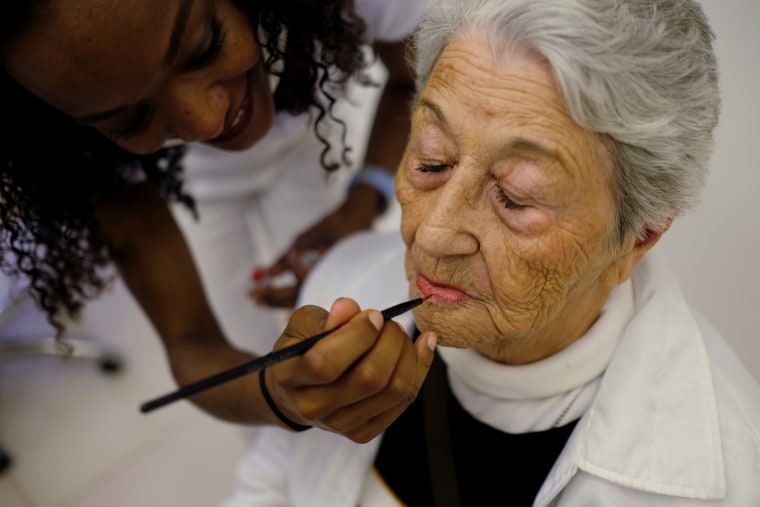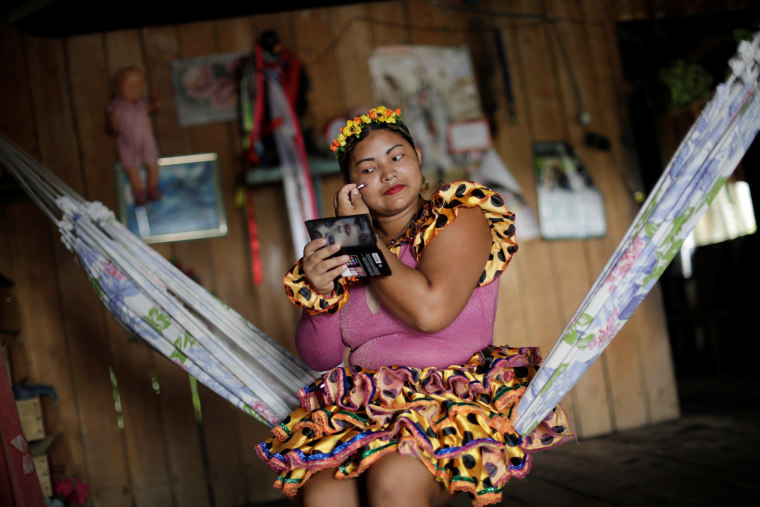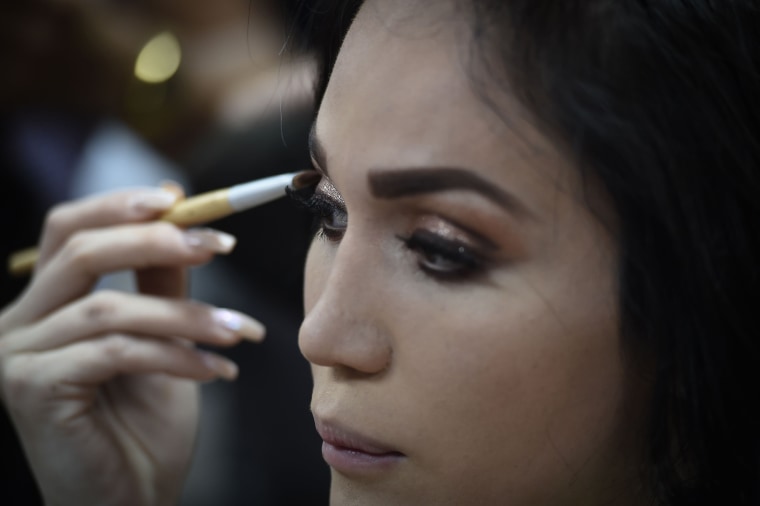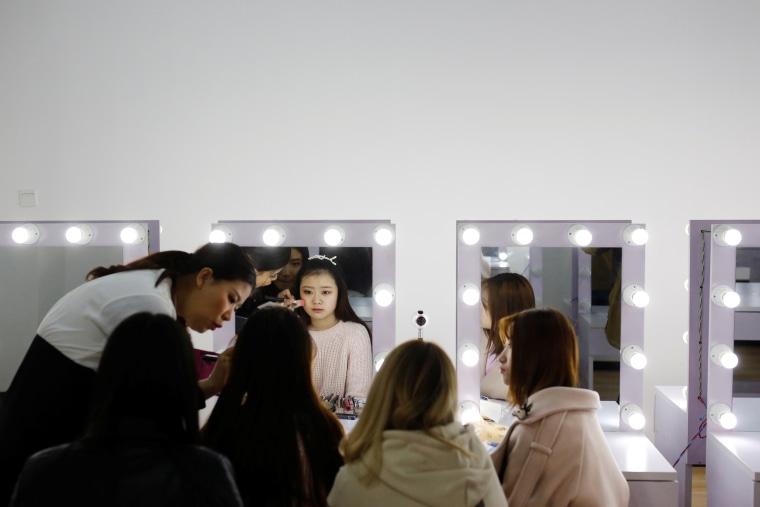I grew up in a time before the internet was a household phenomenon, so my makeup training was limited to a Boy George hair-and-makeup book that I found in a thrift store. It had tutorials that my friends and I executed with drugstore kohl eyeliner melted with cigarette lighters before we went to Rocky Horror. There were selfies at the time, but it took weeks to get the results: I was hand processing and printing from 35mm film. Makeup seemed hard and only worthwhile for special occasions.
It was also pretty hard to find non-traditional makeup at the time: Beauty companies only seemed interested in helping conventionally pretty people look more conventionally pretty, via no-makeup makeup. Most drugstore aisles and makeup counters peddled 50 shades of office-safe beige, tan and pink. I had no interest in spending money to look like the post-makeover Ally Sheedy in "The Breakfast Club," so I gave up makeup for a decade or two.
An acting gig in 2012 forced me into my first makeup shopping trip since the 90s. The play was set in a speakeasy, so I spent plenty of time in the library, looking at vintage makeup tutorials and historical fashion online. (Incidentally, most online Gatsby tutorials are based on Biba Dudu style 1970s revival of 1920s makeup looks, as featured in the Robert Redford film. The real 1920s stuff is smokey, matte and a little sleazy, not so soft focus and definitely devoid of glitter.) After a hearty dose of research, I felt like I had the resources to execute these looks. Makeup went from something completely mystical and frustrating, to a fun tool for summoning a character.

I was still a little intimidated by makeup stores, but found that, since my adolescent dismay at bland makeup counters, new brands had brought editorial makeup to the general public — art supplies for the face! Even the drugstore brands I favored as a teenager now made higher quality rainbows of lipstick and eyeliners that I didn't have to set fire to in order to extract the pigment.
I found it so much fun that I didn't want to be limited to the period makeup I wore during performances. It was a joy after a show to wipe off the dry, cranberry red lip and slip into a silky violet lipstick, iridescent eyeshadow and crisp winged eyeliner. I took daily selfies, documenting each look.
At first, those photos were utilitarian, a way to keep track of makeup combinations I might like to repeat. The selfies evolved into something more as months and years passed — a document of my artistry, my growth from weekend lipstick-wearer to a makeup pro, and, not least, a growing appreciation for my own face. If that sounds vain, I'm okay with that. My journey to seeing my face as something worthy of documentation required years, and eventually, instead of fixating on each of the rarely flattering photos my friends and family took of me, I could see myself more fully.
Selfies helped me to see my evolution as an artist and a person, with slow but sure daily growth. I see the busy days with minimalist makeup and unkempt hair. I see the days where I successfully planned my work and meals and sleep and had time to execute elaborate shadow looks and multilayer gradient lips. Selfies document specifics that show me the whole.

When I was growing up, there were no positive depictions of fat girls on television, and there were certainly none featured in fashion magazines. Camryn Mannheim's 1998 Emmy acceptance speech, where she sang out, "This is for all the fat girls!" as she raised her trophy, thrilled me. However, her traditionally feminine aesthetic didn't speak to me. In the early 1990s, Nomy Lamm published a zine, "i'm so fucking beautiful," which changed my life, but her West Coast riot grrrl aesthetic wasn't like mine either.
Even if there had been a wealth of aesthetic role models, there is something so cool and powerful about putting what you want to see out into the world. Selfie culture allows all people — not just those few who gatekeepers would like to gaze upon — to document ourselves both for personal reasons, and for present and future communities of kindred spirits.
The power of our peers' selfies cannot be overstated for people who don't see themselves in mainstream media. Makeup message boards help economically disadvantaged folks duplicate coveted trendy products. A young trans girl can learn how to neutralize and conceal facial hair stubble in the privacy of her room, thanks to video demos by her peers. I can hop on my Instagram feed and count on seeing avant garde teenage drag queens, Afrofuturists, dramatic and spoopy goth girls, cosplayers and FX artists, Korean beauty glass skin aficionados, sultry women of a certain age and a few soft glam favorites.
There's room for all types of people with all types of aesthetics, and the sheer ubiquity of selfie- and makeup-culture allows all of us the chance to see people outside of a white, cisgender-heteronormative mainstream flourish on our own terms.

There is, of course, a backlash to selfie culture — and a backlash to the backlash. Recently, I ducked down next to a concrete pillar with a poorly stenciled "#stopselfies" tag painted on it, took a photo of myself and immediately texted it to a few close friends who also work with or love makeup. One of them texted back a photo of herself, crisp cat eyeliner and all, next to the same tag.
Denigrations of selfie culture are a projection of the anger of the former gatekeepers of beauty as they lose control.
The would-be gatekeepers of beauty will shout "vanity!" at people like me who have never been deemed worthy of vanity before. For those of us who have traditionally been relegated to supporting character roles (if that) in mainstream media, selfies put us at the center of our own public narratives and allow us to document what the dominant culture doesn't deem worthwhile. Women, people of color, LGBTQIA individuals and anyone at the intersections of these identities can now instantly create a record of our personal growth, expression and the history we are making.
People who rage against the culture of makeup selfies seek to undermine the self-determination of women and queer people who they apparently have no desire to understand. The one-time outsiders have created a visual insider culture. We elevate our community members for our uniqueness. We make safe spaces for our values. The people who have seen themselves reflected in the dominant culture without ever needing to make their own media can be a little salty about that.
Kate Black lives in Brooklyn with 13 cubic tons of books and eyeshadow.

